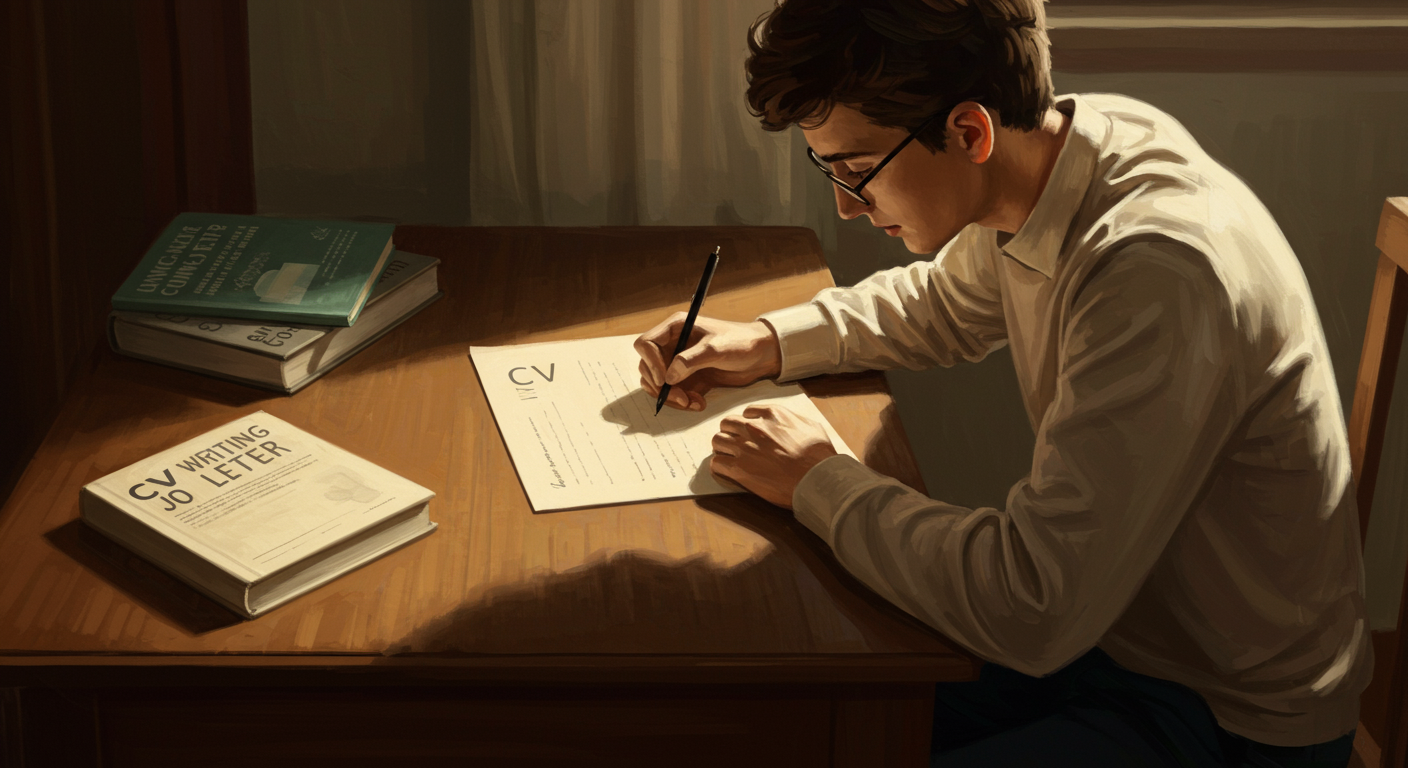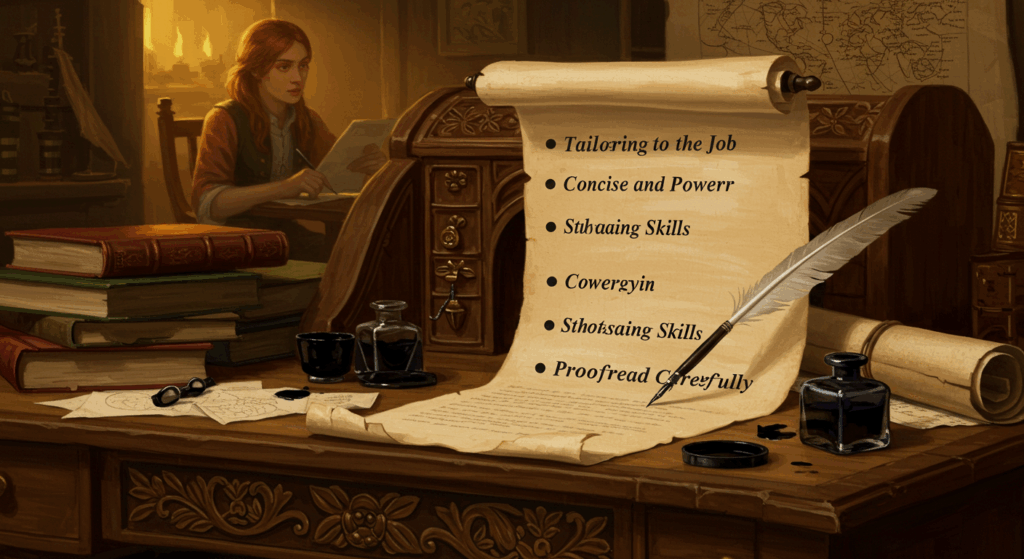Let’s be real: writing a “CV letter” (aka cover letter for your CV) can feel like doing burpees at 6 a.m.—technically possible, spiritually exhausting. You open a blank doc, type “Dear Hiring Manager,” and suddenly remember you need to reorganize your sock drawer. But here’s the deal: a good CV letter can turn a meh application into a “hey, let’s interview them” moment. It’s your quick story—why this role, why you, and why now. No Shakespeare required. Just clarity, good vibes, and a clean format.
Below, I’ll walk you through how to write a CV letter for a job using best practices that actually work right now. We’ll hit format, content, and plenty of examples you can swipe (and tweak) for your own situation. All casual, human, slightly imperfect—like a voice note from a friend who’s been through a few hiring cycles and learned things the hard way. Grab coffee or tea (or, idk, that sparkling water with the mysterious flavor) and let’s do this.
Why Your CV Letter Still Matters (Even in 2025)
People love to say “cover letters are dead.” Meanwhile, hiring managers are like: please tell me why you want this job at this company. Your CV shows the facts (roles, skills, dates). Your letter shows the fit (motivation, values, context). When recruiters are speed-skimning dozens of resumes, a tight, personal letter can be the hook that gets you into the “shortlist” folder.
Also, applicant tracking systems (ATS) scan for keywords. A well-structured letter adds relevant keywords in a natural way—helping you pass the bot test without sounding like a robot. Win-win.
The Simple Strategy (No Overthinking)
- Start with the job description. Highlight what matters most: 5–7 skills or outcomes they repeat (tools, responsibilities, goals).
- Pick your top 2–3 proof points that show you can deliver those outcomes.
- Write a short story where you connect those dots—their needs → your results → your excitement.
- Keep the format clean so humans can skim it in 30 seconds.
- End with a clear, friendly close (and a small call-to-action).
That’s it. You don’t need a novel; you need a thread that makes you feel like the obvious hire.
What Even Is a CV Letter?
Quick definitions so we’re all on the same page:
- CV: a structured document listing your experience, skills, and education (often longer for academic or international roles, but in many places “CV” and “resume” are used interchangeably).
- CV letter / cover letter: a one-page, human-sounding note that introduces your application, summarizes your fit, and motivates the reader to open your CV. Think of it like a movie trailer. Short, punchy, intriguing.
Mindset: You’re Writing to a Tired Human
Hiring folks are juggling Slack pings, meetings that should’ve been emails, and a half-eaten salad. They skim. So you need to respect their attention:
- Specific > fancy. “Led initiatives to enhance synergy” = snooze. “Cut response time 60% by building macros” = interview me.
- Friendly-professional tone. You can sound like yourself without getting cringe. A little warmth goes a long way.
- Clarity first. Short paragraphs, active verbs, real numbers, white space. Your future self (and the recruiter) will thank you.
CV Letter Format: Clean, Skimmable, ATS-Friendly
You asked for best practices, so here’s a simple format that works across industries:
- Length: ~250–400 words (3–5 short paragraphs).
- Font: a basic system font (Calibri, Arial, Helvetica, Georgia). 11–12 pt.
- File type: PDF unless the application says Word.
- Structure: Greeting → Short intro → 2–3 proof paragraphs → Close with CTA → Sign-off.
- Layout: Single column, no images, no text boxes. Keep it straightforward for ATS parsing.
Suggested Heading (optional but neat)
If you want a header (especially for email attachments), mirror your CV header:
Your Name | City, Country (or “Remote”) | email@domain.com | linkedin.com/in/you | portfolio.me
What to Include: The Content That Moves the Needle
Let’s break the content into a simple flow:
- Greeting—use a name if you have one (“Hi Maya,”). If not, “Hello Hiring Team,” is fine.
- Introduction—1–2 sentences that show you did your homework and are excited for this role at this company.
- Proof #1—a strong result tied to a core requirement in the job ad.
- Proof #2—another result, ideally with a metric or concrete outcome.
- Optional Proof #3 or Values/Culture Fit—if you’ve got it, flaunt it; if not, don’t force it.
- Closing/CTA—thank them, offer something specific (“happy to send a short deck,” “can share a quick Loom”), and signal availability.
A Quick “Bad vs Better” for Content
- Bad: “I have good communication skills and work well in teams.”
- Better: “Ran weekly cross-team syncs for 12 people to unblock launches; cut roll-over tasks by ~40%.”
- Bad: “I am proficient in Excel and data analysis.”
- Better: “Built a cost dashboard (PivotTables, lookups) that reduced monthly variance by 22% and saved Finance 4 hours/wk.”
Numbers aren’t mandatory, but they’re spicy. If you can approximate without lying (please don’t lie), do it.
Examples: Realistic CV Letter Snippets You Can Adapt
Example 1 — Marketing Associate (format + content done right)
Hello Maya,
I’m applying for the Marketing Associate role at GreenLoop because your “reuse > new” mission has been on my radar since your pop-up last year—and ngl, I’ve been low-key A/B testing your onboarding emails like a fan. In my current role at Planty, I built a scrappy TikTok program (3 content series/week) that grew us from 0 → 42k in four months and averaged 7.8% engagement.
Your job description highlights lifecycle campaigns and UGC. I rebuilt Planty’s welcome flow (4 steps + segmentation) and boosted activation 15 points while cutting unsubscribes by 28%. On the UGC side, I sourced micro-creators to produce 20 videos/quarter, feeding both paid and organic. Two of those videos drove a referral spike that accounted for 19% of Q3 signups.
I love that you publish sustainability impact updates—transparency builds trust. If helpful, I can share a 2-slide overview of the content tests we ran (what worked + what flopped). Thanks for your time, and I’d be excited to contribute to your fall launch.
Best,
[Your Name]
Example 2 — Customer Success (clean format, concrete content)
Hi Hiring Team,
I’m excited about the Customer Success role at Northbeam because your product solves an issue I wrestled with daily: stitching together insights across messy data sources. At Sparks, I managed 80+ SMB accounts (92% CSAT) and built a “Top 10 Fixes” doc + macro set that cut first response time from ~3 hours to ~1 hour.
On onboarding, I piloted a check-in cadence (Day 2, Day 7, Day 21) that moved activation from 61% → 74% in two quarters. I’m comfortable digging into SQL basics for ad-hoc questions and partnering with PMs to close the loop—our most-viewed help article came from that collaboration and dropped ticket volume ~18%.
If useful, I can share a short Loom walking through my onboarding dashboard. Thanks for considering my application—I’d love to learn more about your roadmap.
Best,
[Your Name]
Example 3 — Career Changer (explain the pivot with confidence)
Hello Hiring Team,
As a high school teacher turned People Ops coordinator, I’ve spent 5 years facilitating tricky conversations, building repeatable processes, and keeping calm when everything is on fire (finals week energy). I’m applying to Glow’s People Ops role because your focus on manager enablement matches the work I’ve already started doing—training new leads and turning feedback into rituals.
At BrightEd, I designed a 3-week onboarding program for new staff (templates, checklists, buddy system) that cut ramp-up time by ~30%. I also implemented a lightweight recognition habit (weekly shoutouts + nominations) that increased engagement survey scores 12 points over two cycles. I’m familiar with Greenhouse, Notion, and Slack automations (hmm, Zapier is my love language).
I’d be happy to share a sample onboarding plan (names redacted). Thank you for your time.
Best,
[Your Name]
Building Your Own Letter: A Lightweight Template
Use this, swap the parts, keep it human:
Greeting
Hello [Name] / Hello Hiring Team,
Introduction (1–2 lines)
I’m applying for the [Role] at [Company] because [authentic reason tied to mission/product/market]. Recently I [relevant mini-win or skill] that maps directly to your focus on [requirement from job ad].
Proof paragraph #1
At [Current/Recent Company], I [action with tool/process], which led to [result/metric]. This work aligns with your need for [mirror a key responsibility/skill].
Proof paragraph #2
I also [second action/result], collaborating with [teams/tools] to [why it mattered]. As you expand [team/feature/market], I’d bring this same playbook and energy.
Optional value/culture line + CTA
I appreciate [company value/specific thing you publish]. If helpful, I can share [artifact: Loom, deck, doc] that shows how I approach [thing you’ll do in the role]. Thanks for your time—I’d love to chat.
Sign-off
Best,
[Your Name] | [LinkedIn] | [Portfolio]
Advanced Tips: Format, Content, Examples That Impress Without Trying Too Hard
- Mirror their language (lightly). If they say “customers,” don’t say “clients.” If they say “users,” roll with “users.”
- Use simple structure. Short paragraphs (2–4 lines), unordered bullets only if necessary.
- Keep tense consistent. Current role in present tense; past roles in past tense.
- Quantify when possible. If you don’t have numbers, use scope: “supported 12-person team,” “ran monthly sessions for ~300 attendees,” “handled 40–60 tickets/day.”
- Don’t over-emoji. A single 🙌 or 🙂 can be fine in the right culture; for conservative industries, skip. Read the room.
Common Mistakes (and Easy Fixes)
- Mistake: Generic intro (“I am writing to apply for…”)
Fix: Lead with a specific hook: “Your Series B focus on onboarding is exactly what I built last quarter.” - Mistake: Tasks, not outcomes (“Responsible for social media posts”).
Fix: Outcomes with evidence (“Grew TikTok 0 → 42k; 2 videos captured paid collabs”). - Mistake: Over-formatted letter (tables, graphics).
Fix: Clean, single column format, consistent fonts, PDF export. - Mistake: Trying to mention every skill.
Fix: Pick the 2–3 most relevant, go deep with examples. - Mistake: Sounding stiff or overly humble.
Fix: Friendly-confident voice: “I’d love to share how we lifted activation 13 points and cut unsubscribes 28%.”
How Your CV and CV Letter Work Together (Like PB&J, lol)
Your CV says what you did. The letter explains why you’re the right person for this role. A quick trick:
- In the letter: pick 2–3 bullets from your CV and translate them into the company’s language.
- In the CV: make sure those same wins are crisp, quantifiable, and keyword-aligned with the job posting.
This makes your application feel cohesive—and makes the recruiter’s life easier.
Quick CV Refresh (So the Letter Has Backup)
While we’re here, a mini CV checklist:
- Header: name, city/country (or “Remote”), email, LinkedIn/portfolio.
- Summary (optional but useful): 2–3 lines framing your specialty and impact.
- Experience: 3–5 bullets per role. Action → context → outcome.
- Skills: tools + functional skills. Keep it honest.
- Education & Certs: in a clean, compact section.
- Format: single column, ATS-friendly, no images, export PDF.
ATS & Keywords (Without Being Weird About It)
- Copy the job description into a doc. Highlight repeated nouns/verbs/tools (e.g., “onboarding,” “retention,” “Zendesk,” “SQL,” “lifecycle”).
- Sprinkle those terms naturally into your content—both CV and letter.
- Use standard job titles in parentheses if your past company used quirky ones: “Customer Success Associate (official title: Customer Happiness).”
- Avoid graphics/text boxes. ATS can be finicky.
International Notes (CV vs Resume, Names, Cultural Stuff)
- In many countries, “CV” and “resume” are interchangeable (CV sometimes longer in academia).
- Photos, birthdays, marital status: common in some regions, not in others. If applying to US/UK, skip personal data.
- If the company is global, stick to a neutral, clean format and keep the content focused on outcomes.
FAQs People Ask Me at Like, 11 p.m.
Q: Do I always need a CV letter?
A: Not always. If the posting says optional, still helpful—especially at smaller companies or roles that value communication. If there’s no upload slot, a tight note in the application box works.
Q: How long should it be?
A: 250–400 words is the sweet spot. Enough to show substance; short enough to skim between Slack pings.
Q: Should I personalize for every application?
A: Yes, but not from scratch. Keep a bank of intros and proof paragraphs. Swap in the relevant examples, tweak the intro, send.
Q: Can I be funny?
A: Light humor = okay. Pun-fest = risky. Startups/creative teams may appreciate personality; banks/government might not. Vibe check the website.
Q: What if I don’t have numbers?
A: Use scope, frequency, and concrete nouns. “Coordinated 12-venue tour; managed weekly vendor calls” is better than “coordinated events.”
Mini Library: Plug-and-Play Phrases (Use Responsibly)
- “I’m excited about [Company] because [specific product/mission/market—you did the homework].”
- “I recently [action] that led to [outcome]; this maps to your focus on [job requirement].”
- “I built [process/tool] to address [problem], which [result].”
- “Happy to share a short Loom/deck with details.”
- “Thanks for your time—looking forward to the conversation.”
Sample Letters by Tone (Because Fit Matters)
A little more formal (still human)
Hello Hiring Committee,
I’m applying for the Operations Analyst role at Clearway because your focus on improving patient scheduling aligns closely with my recent work at Medix. There, I consolidated reporting across three systems into one dashboard, which reduced weekly prep from 4 hours to 45 minutes and improved on-time starts by 11%.
I also partnered with care coordinators to pilot a triage checklist that cut reschedules by ~18%. I’m comfortable with SQL, Power BI, and cross-functional facilitation—and I appreciate that Clearway measures success with patient outcomes, not just throughput.
If helpful, I can share a short summary of the dashboard and change-management steps we used. Thank you for your time.
Best regards,
[Your Name]
More relaxed (startup vibe)
Hey team,
Big fan of what you’re building at Loop—making climate tech feel less doom-y and more do-able is my jam. I led a scrappy lifecycle revamp at Sunbeam (email/SMS + in-app nudges) that bumped activation 14 points and lifted LTV 18% over two quarters. Also obswessed with experimentation (shipped 40+ A/Bs last year).
I can share a tiny deck with the 5 tests that moved the needle, plus the 3 that flopped (equally useful, lol). Would love to help with your fall growth push.
Cheers,
[Your Name]
Editing Pass: Ten-Minute Polish Checklist
- Intro mentions the company name + a specific reason.
- Proof points use clear verbs and at least one number or scope detail.
- Format is clean: short paragraphs, readable font, consistent punctuation.
- File names:
Firstname_Lastname_CV.pdf,Firstname_Lastname_CV_Letter_Company.pdf. - Links work (LinkedIn/portfolio).
- Tone matches the industry (formal ↔ casual).
- Typos handled (read it out loud once—yeah, actually do it).
- CTA included (“happy to share X,” “would love to chat”).
- Length under 400 words-ish.
- Saved as PDF. Always.
Extra Credit: Pairing the CV Letter with a Smart CV Format
Since the letter and CV should vibe together, a streamlined CV format helps:
- Summary: two-line positioning statement.
- Core Skills: tools + capabilities (match keywords).
- Experience: bullets showing outcomes (3–5 each).
- Projects (optional): 1–2 concise case studies if relevant.
- Education/Certs: tight, clean.
- Extras: awards, speaking, open-source, volunteer—if they add dimension.
And yes, content beats design. Fancy templates can break ATS. Keep it simple, readable, and focused on value.
Final Example (All Together, With Format, Content, Examples)
Hello Hiring Team,
I’m applying for the Program Coordinator role at BrightSteps because your mission—expanding access to after-school STEM—lines up with the work I’ve loved most at SparkLab. There, I launched a 10-site pilot (schedules, volunteer training, vendor logistics) that increased weekly attendance 33% while keeping costs flat.
I also built a lightweight data routine (Google Sheets + forms) to track attendance and supplies, which cut last-minute scramble by ~40%. Cross-team coordination is my happy place: I facilitated weekly standups with site leads and ops, shipping a seasonal calendar and a “rainy day” activity bank that reduced cancellations.
I appreciate BrightSteps’ transparent reporting and community partnerships. If useful, I can share a short deck with the pilot plan and the checklists we used. Thanks for your time—would love to talk further.
Best,
[Your Name]
Short, specific, skimmable. The format is clean, the content hits the job’s needs, and the examples make it obvious you’ve done this before.
Wrap-Up: You’ve Got This (Seriously)
Writing a CV letter doesn’t need to be a whole cinematic universe. Keep it human. Use a clean format, pick a few strong content points, and support them with real examples. Show you’ve read the job description, connect your wins to their needs, and close with a friendly, confident nudge.
Now, open that blank doc and try one intro line. Then one proof paragraph. Then the close. Three tiny steps. You’ll have a solid draft before your coffee cools. And when you hit send? Treat yourself—walk, Netflix episode, whatever feels like “I did the thing.”
You’re closer than you think. Go apply, go land that interview, and—ngl—I’m rooting for you.









